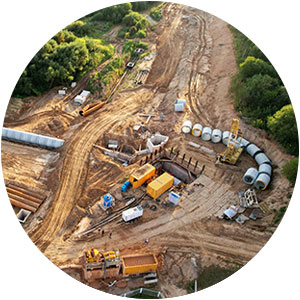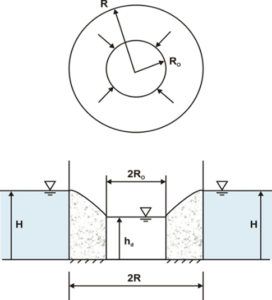 Most excavations below ground level accumulate water. The rate of water flowing in, as well as the disposal of that water, must be carefully managed, and planning ahead is essential.
Most excavations below ground level accumulate water. The rate of water flowing in, as well as the disposal of that water, must be carefully managed, and planning ahead is essential.
The delicate balance of our water supplies can be disrupted by excavation and construction, with impacts on the wider water environment.
To maintain environmental sustainability, regulatory authorities monitor and control the amount of water abstracted, and the amount and quality of water discharged, including hazardous waste. Abstraction licences, environmental permits and waste permits play a central part in this.
Before starting any work below ground level (such as foundations, cable routes, trenches, shafts or tunnels) it is crucial to plan how to treat and dispose of groundwater entering the excavations.
Authorisation may be required to discharge water into the water environment. Surface water run-off may also need to be managed, to direct water away from the excavation during wet weather conditions.
Managing the water getting in
Assessing the rate of water flow
It is crucial to have a detailed understanding of a construction site’s hydrogeological conditions and estimated daily groundwater inflow rates to be able to manage the water successfully and cost-effectively.
A site-specific hydrogeological conceptual site model (HCSM) needs to be developed to calculate groundwater inflow rates. The HCSM combines information on:
 ground conditions obtained through boreholes
ground conditions obtained through boreholes- water level and water quality
- aquifer properties
- the excavation design (depth, length and width).
As one example, the water flowing into the sides of a circular excavation in an unconfined aquifer is calculated using an analytical solution referred to as the Dupuit solution.
See the picture shown in Mansur CI, and Kaufman RI, 1962: Dewatering, in Foundation Engineering, Leonards GA (ed.), McGraw-Hill Inc., New York, New York.
Dewatering
Dewatering is the removal of groundwater, to lower its level and:
- enable safe excavation with stable ground conditions and no submersion
- prevent water from seeping into the site
- protect the overall stability of the site and surrounding area.
Water abstraction and discharge permit regulations vary between Scotland, England and Wales. There are a number of regulatory conditions to comply with, as well as exemptions.
The main discharge conditions are:
- clean water
- no suspended solids
- no adverse impact on surface water
- not located less than 500 metres upstream of a conservation site (e.g. SSSI)
- the duration is limited to no more than three consecutive months.
A permit is not required for short-term, temporary dewatering from excavations and discharge of uncontaminated water, which is wholly or mainly rainwater, into surface water (eg. pumping water out of excavation on a building site).
A water abstraction or impoundment licence is required for abstraction of more than 20 cubic metres of water per day.
Bespoke discharge permits are required for pumping out contaminated water or water from quarry activities.
Managing the water going out
There are three main discharge options for the abstraction of water flowing into excavation sites.
- Discharging water direct to ground (local retention basin and soakaway).
- Discharging water into a local stream.
- Taking water off site in tankers and discharging elsewhere as waste water.
The best choice of option will depend on water volumes (inflow rates), water quality and site-specific ground conditions.
Discharging water direct to ground is unsuitable where:
- there are low-permeable, clay-rich superficial deposits
- the groundwater table sits close to the ground surface, risking water infiltration through the soakaway, leading to surface flooding in the site.
Discharging water into a local stream requires:
- the appropriate regulatory licence
- an H1 water quality risk assessment to demonstrate to the regulator that the surface water feature will not be negatively impacted by the discharge.
Taking water off site in tankers requires the added expense of discharge as waste water.
When to begin water management
Water management should be included in the early design stage, at least six months before construction.
This allows sufficient time to collect data on:
- baseline water quality
- seasonal water levels.
The detailed HCSM and water inflow rate calculations are the foundations for a successful discharge consent application.
If authorisation is needed to discharge to a watercourse, it can take up to four months to obtain.
The last word
WHS’ water services include a full abstraction licence application service.
We act as the agent throughout the determination process, designing and/or negotiating the best licence for the project.
We have detailed knowledge and understanding of catchment hydrology, hydrogeology, environmental impact assessment and, most importantly, how the regulators work.